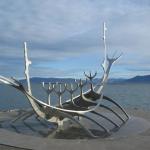Iceland Sights
 Iceland offers tourists an excellent opportunity for travel, a huge number of routes that allow to get acquainted with almost all the attractions of the island.
Iceland offers tourists an excellent opportunity for travel, a huge number of routes that allow to get acquainted with almost all the attractions of the island. In Iceland, for tourism have all the conditions and there is every thing-thing: "Blue Lagoon" - the most popular thermal facility in the country. The most popular tour - "Golden Ring", during which the tourists visiting the Valley of Geysers, the National Park Tingvellir with lake and waterfall Tingvallavatn Galfos. Waterfall Galfos - largest, most powerful waterfall in Europe. He falls down two ledges with a height of 30 m. The tourists can come very close to a special trail or enjoy the view of the falls from the top of the nearest cliff.
A special attraction are the hot springs of Iceland - geysers. The most surprising is that the landscape of Iceland is still changing, and the island continues to grow. Iceland - a place where anyone can see something new and get a lot of unforgettable impressions.
Reykjavik - the most northerly metropolis in the world, just north of 64 parallel, located on the legends of the Icelandic sagas into the place where the first permanent settler Ingolfur Arnarson built his home in the 874 year. Called the first settler Reykjavik or Dymna Bay "for the eruption of steam from its geothermal hot springs, the capital of Iceland is now completely got rid of the last steam smoke. Main sights - this is his most natural open spaces, for example, the area along the river banks Ellidaar that flows through the eastern part of the capital, and rightly, considered one of the richest rivers in Iceland, where the usual salmon. Reykjavik - is also a concentration of commerce, industry, government and culture. The city has many cultural attractions, especially during the Reykjavik Arts Festival, is being done every two years.
Reykjavik - a center of local communications by land, air or water, in the head office of the major shipping companies, airlines and the leading exporters and importers, as well as their own thriving industrial, municipal and commercial sector.
Reykjavik has become an independent city with a population of 302 persons in 1786, but its population is about 106 000 people. Reykjavik and its neighboring cities make up 60% of the total population of Iceland. Among the ancient buildings in Reykjavik - The Parliament House (built in 1881) and the old Government Building (the mid 18 th century), both located in the old center of Reykjavik between the harbor and the lake. Arbersky folk museum exhibits a number of old houses in Reykjavik, reconstructed in original style, the church in a traditional style with a roof covered with turf and farm houses of the nineteenth and the beginning.
Outside of Reykjavik, the population is much less dense and scattered all over the lowlands and plains and the coast with several important cities located in each of their parts. In the north of Iceland's largest city of Akureyri - "capital" of the region, which plays a very important role in commerce, communications, tourism, winter sports, culture and education.
In the Western Ferdah in the north-west of Iceland's largest city - Isaferdur, a fishing town, as well as the center of culture and education.
The eastern part of Iceland's much less populated than the north. The largest city, located on its shores, fjords useennom - Neskaupstadur. But the city Igilstadir, located within the region is its administrative center.
South-west peninsula - the most densely populated area of Iceland, which is the center of Reykjavik. Since it borders the city of Reykjavik Kopavogur, which has increased markedly since the Second World War, a few kilometers from the city lies the town of Hafnarferdur, old fishing and trading center, now a growing industrial center. Near the international airport in the south-western peninsula is the town of Keflavik, and fishing port. And on the other end of the bay from Reykjavik Akranes is - the leading fishing port and the location of the country's only cement plant. In the fertile soil of the southern plains are four rural towns, the most important of which Selfoss - the center of commerce and agricultural production with the largest dairy industry in the country.